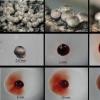
06-12-2025 00:19
 Viktorie Halasu
Viktorie Halasu
Hello, would anyone have this article, please? An

05-12-2025 17:33
 Bruno Coué
Bruno Coué
Bonjour, je serais heureux de recueillir votre avi

02-12-2025 18:59
This pair of ascos 2.5cm across were on recently b

02-12-2025 19:25
Buckwheat PeteHello, can anyone identify this hairy fungus growi

30-11-2025 12:53
 Edvin Johannesen
Edvin Johannesen
White short-stipitate apothecia found on thin twig

30-11-2025 10:47
 William Slosse
William Slosse
I recently found a collection of small Peziza sp.
Bloody Hypoxylon!?
Dartanha Soares,
11-04-2016 23:18
 Hi to all,
Hi to all,Found this one on decorticated wood (unknown), but I did not have much time to work on it.
Ascospores are 12.5-14.5x5.6-6.5 micra, with sigmoid germ slit (full spore length), perispore dehiscent.
What called my attention was the "red-blood" pigment on KOH 10%.
Any hint will be welcome.
Jacques Fournier,
12-04-2016 08:39

Re : Bloody Hypoxylon!?
Hi Dartanha,
this is strongly suggesting H. lenormandii but the red pigments in KOH are indeed deviaiting from those encountered in typical H. lenormandii. It is worth a more detailed study.
Cheers,
Jacques
this is strongly suggesting H. lenormandii but the red pigments in KOH are indeed deviaiting from those encountered in typical H. lenormandii. It is worth a more detailed study.
Cheers,
Jacques
Dartanha Soares,
12-04-2016 13:44

Re : Bloody Hypoxylon!?
Hi Jacques,
Thank you very much.
I looked at Kuhnert et al. paper (Fungal Diversity (2015) 71:165–184) and it fits well. They mentioned that this fungus "have Blood colour (3) and Dark Vinaceous (84) pigments in KOH", and is already reported from Brazil (a single specimen collected by Rick in 1906!!).
But as you said, it deserves further studies, since according to them "H. lenormandii" seems to be a species-complex.
Once again, thank you very much!!
Thank you very much.
I looked at Kuhnert et al. paper (Fungal Diversity (2015) 71:165–184) and it fits well. They mentioned that this fungus "have Blood colour (3) and Dark Vinaceous (84) pigments in KOH", and is already reported from Brazil (a single specimen collected by Rick in 1906!!).
But as you said, it deserves further studies, since according to them "H. lenormandii" seems to be a species-complex.
Once again, thank you very much!!
